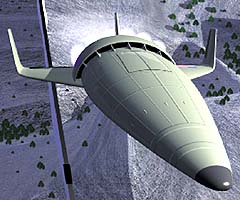| . |  |
. |
 Huntsville - November 23, 1999 - The leaders of NASA's advanced space transportation activity have a vision for the opening century of the third millennium: human settlements on other planets within 100 years.
Huntsville - November 23, 1999 - The leaders of NASA's advanced space transportation activity have a vision for the opening century of the third millennium: human settlements on other planets within 100 years."If you look at where we were as a civilization 1,000 years ago, or just 100 years ago," said Garry Lyles, manager of the Advanced Space Transportation Program at NASA's Marshall Space Flight Center in Huntsville, Ala., "it's quite realistic to expect human settlements in space in the 21st century." As with any pioneering adventure, trailblazers must clear the way to the frontier. In the case of the Final Frontier, it requires building a highway to space. "Safe, reliable, affordable transportation has been the key to exploration and development of frontiers that emerged throughout history," said Dr. Row Rogacki, director of the Space Transportation Directorate at the Marshall Center. "And transportation is again the driver as we boldly prepare to explore and develop the largest frontier of all - the space frontier." Ocean-going vessels enabled discovery of the New World and initiated global commerce. The stagecoach transported early settlers and cargo across the untamed American West, and the transcontinental railway opened up this new frontier to vast numbers of settlers and commerce. Modern airways are a critical element of international travel today. And with the dawn of the new century, space transportation can expand our global economy to a universal economy. "Once we bring the cost and safety of space transportation in line with today's airlines, I believe we'll have a growth of people doing business in space," said Lyles. "The opportunities for scientific research and new space industries are limitless." Possibilities he lists include:
"NASA's role is to develop innovative technologies so our industry partners can develop commercially viable space launch vehicles that meet NASA's needs," said Rogacki. The X-33, X-34 and X-37 technology demonstrators scheduled to fly in the early years of the 21st century are designed to reduce space transportation costs from today's price tag of $10,000 per pound to $1,000 per pound before 2010. Marshall's Advanced Space Transportation Program is pushing technologies to reduce that cost to only hundreds of dollars per pound by 2025 and a bargain price of tens of dollars per pound midway through the new century. At the same time costs are decreasing, safety and reliability will be increasing to a level that will surpass today's airline transportation. In fact, spacecraft of the future will be equipped with intelligent vehicle health management systems that allow a launch vehicle to determine its own health without human inspection. One radical technology being developed at Marshall and other NASA centers is a rocket engine that breathes oxygen from the air during the climb to orbit. A magnetic levitation track that uses magnets and electricity to accelerate a vehicle at speeds up to 600 mph could give a launch vehicle a running start before it leaves the planet. Propulsion systems that boost spacecraft with laser beams and propellant-free electrodynamic tethers could also become operational within the first half of the 21st century. An attractive feature of these advanced propulsion technologies is that the energy to propel the vehicle doesn't have to be carried on board, resulting in significant weight and cost reductions and better performance. Marshall scientists and engineers are conducting fundamental research into exotic, high-energy propulsion required for travel to the outer planets and other star systems. Sails propelled through space by sunlight - just as wind pushes sailboats on Earth - could be used for an interstellar precursor mission as soon as 2010. Marshall is also experimenting with antimatter, fusion and fission as propulsion alternatives for deep space travel in the third millennium. And NASA is also involved in basic research on the leading edge of modern science and engineering, such as space and time warping, gravity manipulation and theories that might enable faster-than-light travel. Through intense technology development that will make space transportation safe and affordable for ordinary people, NASA is building a highway to space for the 21st century and unlocking the door to the final frontier.
Series of Position Papers in PDF Format
RLV ALERT
|
| |||||||||
| The content herein, unless otherwise known to be public domain, are Copyright 1995-2016 - Space Media Network. All websites are published in Australia and are solely subject to Australian law and governed by Fair Use principals for news reporting and research purposes. AFP, UPI and IANS news wire stories are copyright Agence France-Presse, United Press International and Indo-Asia News Service. ESA news reports are copyright European Space Agency. All NASA sourced material is public domain. Additional copyrights may apply in whole or part to other bona fide parties. Advertising does not imply endorsement, agreement or approval of any opinions, statements or information provided by Space Media Network on any Web page published or hosted by Space Media Network. Privacy Statement All images and articles appearing on Space Media Network have been edited or digitally altered in some way. Any requests to remove copyright material will be acted upon in a timely and appropriate manner. Any attempt to extort money from Space Media Network will be ignored and reported to Australian Law Enforcement Agencies as a potential case of financial fraud involving the use of a telephonic carriage device or postal service. |